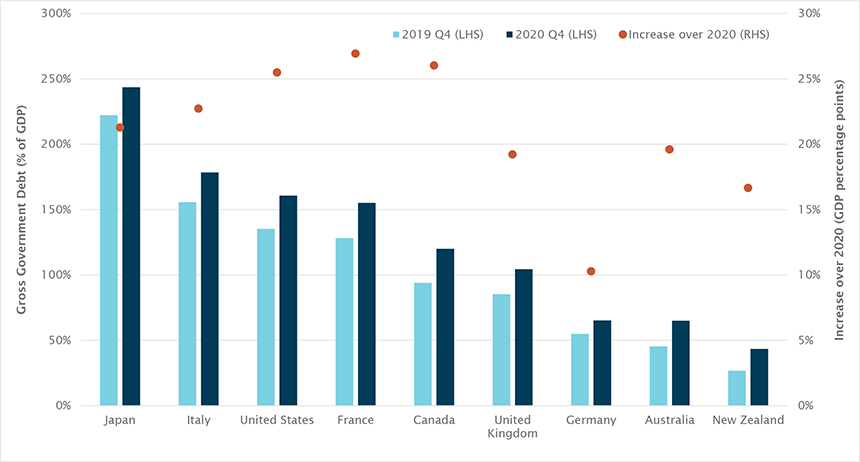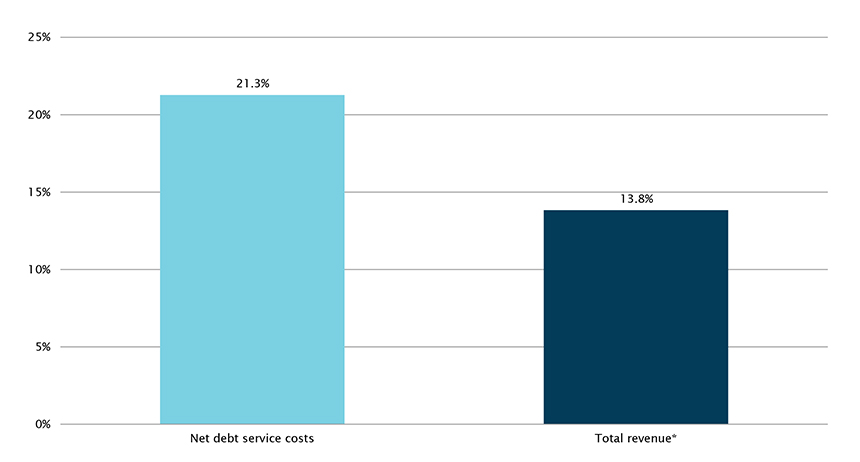Budget Review 2021–22 Index
Rob Dossor
|
Gross
debt is the
face value of Australian
Government Securities (AGS) (Treasury bonds and notes) on issue.
More often reported, net
debt is the sum of all financial liabilities (gross
debt) of a government less its respective financial assets (see OECD Glossary of Statistical terms).
Gross
debt indicates
the magnitude of debt owed, but it does not show whether a government can repay
that debt and provides limited detail about the overall financial health of a
government. This is where net
debt is significant. If a government has a gross debt of 50 per
cent of GDP, but has large amounts of cash and/or assets (low net debt), then
it is in a much better position to handle this level of debt.
|
The Budget projects that the Commonwealth government’s gross
debt will be around $963 billion at 30 June 2022. This is around 45.1% of
GDP. It is projected to increase to $1,199 billion—around 50% of GDP—by 30 June
2025 (Budget
Strategy and Outlook: Budget Paper No.1: 2021–2022, Table 11.5,
p. 366–7).
Net debt is expected to be $729 billion—or 34.2% of GDP—at
30 June 2022 and peak at $981 billion or 40.9% of GDP in 2024–25 (Table 11.4, p.
364–5). Net debt is then projected to fall over the medium term to 37% of GDP
at 30 June 2032 (p. 203).
Australia’s forecast debt levels are slightly lower than
what was projected in the 2020–21 Budget, which forecast gross debt to reach
$1,138 billion by 30 June 2024, compared to $1,134 billion for the same period,
in this Budget.
These gross and net debt levels are shown, to 2024–25, in
Chart 1 below.
Chart 1: gross
and net debt levels

Source: Budget
strategy and outlook: budget paper no. 1: 2021–22, Statement 11, p. 365 and 367.
International comparison
It is not surprising that debt levels have increased so
significantly during the COVID-19 pandemic which has led to a considerable
increase in government spending.
Australia’s debt level, however, remains low compared to
most developed countries. As shown in Chart 2, Australia’s pre-pandemic debt
was lower than most comparable countries and this remains true post-pandemic. In
2020 Gross Government Debt (for all levels of Government) increased across all
major economies depicted in Chart 2, with Australia’s increase of just
under 20%, similar to the UK and New Zealand, and below the US, Canada, and
France.
Chart 2: gross
Government debt, international comparison

Source: Oxford Economics
Debt sustainability
The amount of Commonwealth debt is causing some commentators
to be concerned that the Commonwealth may have to devote an increasing share of
revenue to meet interest expenses, and that this may lead to a need to increase
taxes, cut spending, sell assets and/or further increase debt. Tim
Colebatch, for instance, argues that this will leave the job of servicing
and repaying the debt to future generations.
An alternative view is expressed in the Budget which notes
that stronger economic growth expected over the coming years, coupled with low
costs of servicing debt, will enable the Government to maintain a steady and
declining ratio of debt to GDP over time, while running a modest deficit.
This view finds support from other observers who argue that,
although Australia’s debt levels have risen dramatically in the last year, commensurate
with the international experience, debt levels are not a cause for concern,
largely due to low interest rates.
Guy Debelle, Deputy Governor
of the Reserve Bank of Australia (RBA), for example, said in a speech
in November 2020:
in Australia, public debt is
very manageable. Public sector debt remains low as a share of GDP for the
Australian Government … Borrowing costs are likely to remain very low for quite
some time, and almost certainly until the economy is considerably stronger.
This means that the debt dynamics for the Australian Government and the states
and territories are absolutely sustainable.
The International
Monetary Fund (IMF) outlines that a number of factors determine how much
debt a country can carry before the burden becomes excessive, including the
quality of institutions and debt management capacity, policies, and
macroeconomic fundamentals. Generally speaking, Australia’s institutions, policies,
and macroeconomic fundamentals are considered to be robust.
An earlier (2018) IMF
working paper outlines that the critical factor determining a country’s
maximum sustainable debt level is the difference between its future nominal
interest rate and its growth in economic activity. When the growth in cost of
servicing the debt (i.e. the interest) is lower than the rate of economic
growth, then the debt will be sustainable, as the economy is growing faster
than the debt servicing costs. Australian economist Professor John Quiggin makes
a similar point, provided that inflation stays moderate and there is
productivity growth.
Chart 3 below, shows that the cost of servicing Australia’s
forecast debt is predicted to increase faster than forecast Australian
Government revenue (not including GST). While this may cause some concern, it
should be noted that the cost to service this debt remains consistent at 0.7%
of GDP over the medium-term forecasts, as shown by Chart 4. This occurs because
real GDP is forecast to increase by 4.25% in 2021–22, and then moderate to between
2.25% and 2.5% over the forward estimate periods, and the expectation is that
interest rates will remain low for some years.
The Budget’s growth forecasts are consistent with those of
the RBA and Oxford Economics. The RBA in its May
2021 Economic Outlook forecasts GDP growth of 4% in 2021–22 and 3% in
2022–23. Oxford Economics in its May 2021 Economic Outlook Australia forecasts GDP growth of 3.6% in 2021–22 and 2.4% in 2022–23. Both the RBA and Oxford
Economics forecast that CPI inflation will remain subdued in the medium term.
Chart 3: net
growth over forward estimates, cost to service Australian Government debt and
Australian Government revenue

*Includes total receipts excluding GST and non-taxation
receipts
Source: Budget
strategy and outlook: budget paper no. 1: 2021–22, Statement 11, p. 365 and Statement 5, p. 129.=
Chart 4:
Australian Government Securities Interest cost and Government revenue

Source: Budget
strategy and outlook: budget paper no. 1: 2021–22, Statement 11, p. 365.
The Parliamentary Budget Office (PBO), in its recent Fiscal
Sustainability Report, assessed the way that different
levels of interest rates, economic growth and the Government’s budget balance would
affect the sustainability of the Government’s debt position. Of the 27
scenarios tested, the PBO found:
only the highly unlikely scenario of a generation of low
economic growth combined with high interest rates and large budget deficits
results in debt increasing as a share of GDP, after 2050.
The scenarios also show that a sustainable fiscal position
can be maintained even if the budget remains in a modest deficit position over
the long term, although reaching that position will require governments to
continue to increase revenue and/or contain spending to return the budget
balance to the average levels recorded over time. (p. iii)
Finally, it should be noted that an economy does not need to
pay off debt to bring down the relative level of debt. As an economy grows, provided
the debt is stabilised, the debt will shrink relative to the size of the
economy
Risks
Recently, an article in the Australian
Financial Review warned that Australia could lose its AAA credit rating
as soon as September 2021, due to the Budget forecast of persistent budget deficits
over the next decade. A downgrading to AA+ could result in higher interest rates
on new debt.
Whether Australia’s credit rating changes or not, an
increase in interest rates will increase the cost of issuing new debt. If
interest rates were to rise significantly, it would put upwards pressure on the
sustainability of debt, in the same manner as a downgrading of Australia’s
credit rating.
Only if Australia’s debt servicing costs become
unsustainable would it be a cause for concern, as the PBO noted.
Australia’s relatively low pre-pandemic debt position
allowed debt to increase dramatically, but within the sustainable envelope. This
debt level is not forecast to begin reducing until the 2025–26 financial year,
which raises the question–in the event of another economic shock, will
Australia be able to further leverage the balance sheet and stimulate the
economy?
The IMF
notes that advanced economies with ample fiscal space (such as Australia)
may not need to worry about the ability to respond to future economic shocks, but
those with very high debt may need start thinking about the implications. As
the comparison above shows, Australia has relatively low debt and so will
likely retain fiscal capacity to respond to future economic shocks.